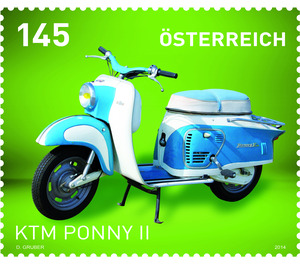motorcycles - Austria / II. Republic of Austria 2014 - 145 Euro Cent
Theme: Traffic, Transportation & Mobility
| Country | Austria / II. Republic of Austria |
| Issue Date | 2014 |
| Face Value | 145.00 |
| Edition Issued | 230,000 |
| Printing Type | offset |
| Stamp Type | Commemorative |
| Item Type | Stamp |
| Chronological Issue Number | 2454 |
| Chronological Chapter | OOS-OE2 |
| SID | 940969 |
| In 68 Wishlists | |
The new value of the special stamp from the popular series "Motorcycles" shows the KTM Ponny II. In 1945 there were about 10,000 motor vehicles in Austria, in 1955 it was just under 150,000, and the development of the engine was just at the beginning. Founded in 1934, KTM - "Automobile Trunkenpolz Mattighofen" and later "Kronreif & Trunkenpolz Mattighofen" - was at the forefront of motoring Austria with two-wheelers such as the R 100, Tarzan, Mustang or RS 125 and served with the models "Mecky" and "Mirabell" also the growing market of scooters. Although a small slump interrupted the economic miracle in 1958, KTM was already able to present the right vehicle at the right time in 1960: the KTM Ponny scooter. This was visually similar to his "big sister" Mirabell, but the Mirabell was a scooter with fan-cooled Rotax engine of 125 and 150 cubic centimeters, respectively, whereas the Ponny was a size smaller. Already in 1957 KTM had with the "Mecky" the world's first scooter scooter, d. H. a scooter with a self-developed 50 cubic centimeter engine, presented. The concept of the small engine came from Ludwig Apfelbeck, and at 47 kilograms, the "Mecky" was a real lightweight. From 1960 KTM relied entirely on the moped business and stopped the traditional motorcycle production. The KTM Ponny was tailored precisely to the new customer base: comfortable chassis, optimized splash protection for driver and front passenger and of course a chic design with twin headlights and two-tone paint and white wall tires - in the style of American road cruisers. The commercial success was the Mattighofnern right: Both in Austria (with the 3-speed Puch engine) and in Germany (with Fichtel & Sachs engine of Gritzner & Kaiser and distributed by Rabeneick) was the KTM Ponny a complete success - until 1962, nearly 40,000 first generation units were sold. In 1962, the largely redesigned KTM Ponny II was presented - with a completely new body with free-through and improved splash protection, the new model was so convincing that it should remain more or less unchanged for an unbelievable 25 years in production. From 1967 there was the KTM Ponny in elegant silver metallic, from 1968 with 4-speed foot gear, from 1973 in green and from 1974 in blue metallic, with decorative stickers and turn signals. In 1977 the KTM Ponny got new fittings and a bright green metallic for the standard version and a blue metallic for the L version. In 1982, the production of KTM Ponny was discontinued and the successful model replaced by the KTM 50 GSA, a cooperation project with Gilera. But the demand forced a renewed production start, and thus developed between 1984 and 1987 again 1,892 copies in Rotmetallic - in total were built up to the cessation of production on 18.12.1987 about 120,000 pieces.


